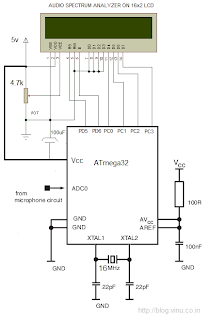“All waveforms, no matter what you scribble or observe in the
universe, are actually just the sum of simple sinusoids of different
frequencies.”
I am just refreshing the basics of fourier transform. I am not an
expert. Now I did a small audio spectrum analyzer(0 – 10KHz) on a 16×2
character lcd using an atmega32 microcontroller. Since I am refreshing
from the basics, so I started with simple DFT. Also, I believe I should
learn to walk before running. So I am not straight away going towards
the FFT, which is nothing but the fastest and a bit complicated
algorithm to find DFT.(I will try it later, as soon as possible)
DFT is too slow compared to FFT. My lcd spectum analyzer doesn’t
need a great speed like that of an FFT, now if it is capable of
providing a speed of around 30 frame/second, then it is more than enough
for visualizing the audio spectrum on an LCD. But any way, in my case I
can roughly achieve around 100 frames/second(any way it is too high
refresh rate for a 16×2 lcd, not recommended also  ). My audio sampling rate is 20KHz for 32 point DFT. Since the
transform result is symmetric, I need to use only the first half, ie the
first 16 results. So, it means, it can display upto 10KHz spectrum. So
the resolution is 10KHz/16 = 625Hz.
). My audio sampling rate is 20KHz for 32 point DFT. Since the
transform result is symmetric, I need to use only the first half, ie the
first 16 results. So, it means, it can display upto 10KHz spectrum. So
the resolution is 10KHz/16 = 625Hz.
I have tried to improve the speed of DFT computation. If
it is an N point DFT, it needs to find (N^2)/2 sin and cos values. For a
32 point DFT, it needs to find 512 sine and cosine. Before finding the
sine and cosine, we need to find the angle(degree) which takes some
processor time, so I implemented a lookup table for that. Next two
tables are for sine and cosine. I didn’t used any float or double since
it takes more processing time in 8 bit avr, instead I implemented the
sine and cosine lookups as 16bit intiger, by multiplying the real sine
and cosine values by 10000. Then after finding the transform, finally I
need to divide each result by 10000. This eliminates the need of using
float or double and makes it more faster. Now I can calculate 120 32-point DFT operation/sec which is more than enough for my small spectrum analyzer.
LCD
Now, looking towards the LCD side, I utilized the custom
character feature of LCD to make 8 stacked horizontal bars which takes
the entire 64bytes of the LCD RAM for custom character bitmap. I ones seen a video is hackaday.com that a person used a 16×2 lcd in the similar manner for his spectrum analyser. So I also adopted the same idea of using the custom character for my spectrometer.
AUDIO INPUT
Now one of the most important part of this stuff is the
audio sampling via an eletret microphone. Special care must be given
while designing the pre-amp for the mic. We need to set the zero-level
of the ADC input to exactly half of the ADC reference voltage ie to
2.5v. Now it can have positive and negative swing on this 2.5v level
according to the input audio signal but it should not cross the limit ie
the amplifier gain should be properly adjusted to prevent clipping. I
am using an LM324 op-amp for the mic pre-amp to meet the above
conditions.

No comments:
Post a Comment